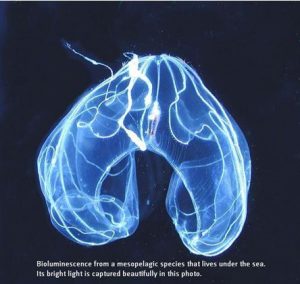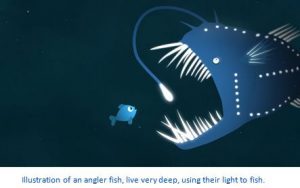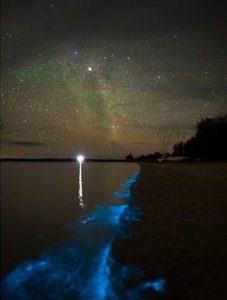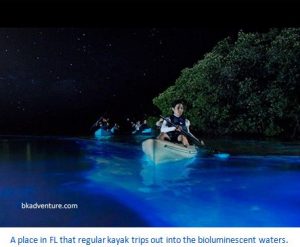By Terry Sovil from the August 2017 Edition
What? Bioluminesence. I get confused thinking about it and think about “fluorescence” or “phosphorescence” or “luminous”. Bioluminescence is the production, and emission of, light by a living organism. While I think of it mostly in terms of marine life, there are terrestrial invertebrates that can create light. Think of fireflies but also some fungi, bacteria, etc.
“phosphorescence” or “luminous”. Bioluminescence is the production, and emission of, light by a living organism. While I think of it mostly in terms of marine life, there are terrestrial invertebrates that can create light. Think of fireflies but also some fungi, bacteria, etc.
Many people have a “luminous” watch and sometimes luminous paint. This is really a phosphorescence similar to fluorescence: the process by which energy-saving lights produce light. In this case, it takes time to “charge” the paint and it will glow for a while in the dark. But it will eventually fade, since paint is not an organism and can’t produce its own light. Bioluminescent organisms can glow in complete darkness!
Fluorescent materials will produce light instantly. Atoms inside them absorb energy and become “excited.” When the atoms return to normal, in as little as a hundred thousandth of a second, they give out the energy that excited them as tiny particles of light called photons. Invisible ink is a fluorescent chemical. Turning a UV light on causes the atoms to be become ex-cited and they show light. Turn off the UV light and they go dark.
 The U.S. Navy sought help from the science community to help develop products that can monitor bioluminescence. It seems that having algae that glows when disturbed may endanger a military mission.
The U.S. Navy sought help from the science community to help develop products that can monitor bioluminescence. It seems that having algae that glows when disturbed may endanger a military mission.
Bioluminescence is a fascinating spectacle. Fireflies, glow worms and deep sea animals can emit light that they produce. But also many plants, such as algae, can too. It is a light coming from a living organism. It is produced from a chemical reaction, just like a chemical glow stick that you snap to activate, which is what sets it apart from phosphorescence or fluorescence. It is found in bacteria, algae, jellyfish, worms, crustaceans, sea stars and fish.
There are two chemicals that must be present for an organism to luminesce, or glow. Lucifern and Luciferase. Lucifern pro-duces the light and luciferase is the catalyst. In the sea, a chemical called coelenterazine is a type of luciferin and that combines the luciferase to create the light.
Sailors see the waves glowing in a ship’s wake. Everyone can see the lights from waves washing up on the beach. These are dinoflagellates, a single-celled algae, which glows when it is startled.
Anglerfish use a long appendage that can be lit to attract prey. They may stun the prey or perhaps attract a  mate. Sometimes, it is a defensive action to startle predators. Sperm whales, the deepest diver of all whales, depend on bioluminescence to locate food. The pulsing light of creatures deep in the ocean is perhaps the most common form of communication.
mate. Sometimes, it is a defensive action to startle predators. Sperm whales, the deepest diver of all whales, depend on bioluminescence to locate food. The pulsing light of creatures deep in the ocean is perhaps the most common form of communication.
Illustration of an angler fish, live very deep, using their light to fish.
For some deep sea creatures, bioluminescence allows them to produce a red light that others cannot see. They can see their prey without making their presence known. Marine creatures produce light with a special organ called a photophore. This is where the two chemicals are “blended” to produce the light. Some creatures have the ability to charge and then exhale or expel many small particles. This will distract and confuse a potential predator.
So, can I see it here, in Manzanillo? You may recall that our own Las Hadas, which translates to “The Fairies”, got its name from the bioluminescent plankton prevalent in the ocean that would glow and light up the water due to the wave action.
There are some areas where the bioluminescence is always there. A group in Florida offers night kayak tours. You can find them in Orlando at bkadventure.com. See one of their photos in the article.
Mexico does have some beaches that are known to pretty consistently produce bioluminescent glow for people to watch.
These are:
- Holbox, Quintana Roo
- Xpicob, Campeche
- Laguna de Manialtepec, Oaxaca
- Parque Nacional Lagunas de Chacahua, Oaxaca
 Of course the glow is only visible at night. We have been diving at night at Club de Yates in Salagua on the peninsula and seen the bioluminescence from divers moving through the water. It is mesmerizing and can often get more attention than the critters swimming around. Each fin kick creates a glow of light that is incredible to witness. It is nearly impossible to photograph because it’s dark and a strobe is required to compensate. A quality camera can capture it from the surface.
Of course the glow is only visible at night. We have been diving at night at Club de Yates in Salagua on the peninsula and seen the bioluminescence from divers moving through the water. It is mesmerizing and can often get more attention than the critters swimming around. Each fin kick creates a glow of light that is incredible to witness. It is nearly impossible to photograph because it’s dark and a strobe is required to compensate. A quality camera can capture it from the surface.
You may sometimes observe a bright blue flash when snorkeling, scuba diving or swimming with goggles during the day. This isn’t a form of bioluminescence. It is a small copepod that flashes when it turns just right to reflect the sun. I’ve had divers out where we saw them everywhere as we all made entries and then grouped up for a descent.
National Geographic created a special “starlight camera” and for the first time ever was able to video the beauty of the creatures and people and bioluminescence.
Download the full edition or view it online
—
Terry is a founding partner and scuba instructor for Aquatic Sports and Adventures (Deportes y Aventuras Acuáticas) in Manzanillo. A PADI (Professional Association of Dive Instructors) Master Instructor in his 36th year as a PADI Professional. He also holds 15 Specialty Instructor Course ratings. Terry held a US Coast Guard 50-Ton Masters (Captain’s) License. In his past corporate life, he worked in computers from 1973 to 2005 from a computer operator to a project manager for companies including GE Capital Fleet Services and Target. From 2005 to 2008, he developed and oversaw delivery of training to Target’s Loss Prevention (Asset Protection) employees on the West Coast, USA. He led a network of 80+ instructors, evaluated training, performed needs assessments and gathered feedback on the delivery of training, conducted training in Crisis Leadership and Non-Violent Crisis Intervention to Target executives. Independently, he has taught hundreds of hours of skills-based training in American Red Cross CPR, First Aid, SCUBA and sailing and managed a staff of Project Managers at LogicBay in the production of multi-media training and web sites in a fast-paced environment of artists, instructional designers, writers and developers, creating a variety of interactive training and support products for Fortune 1000 companies.




